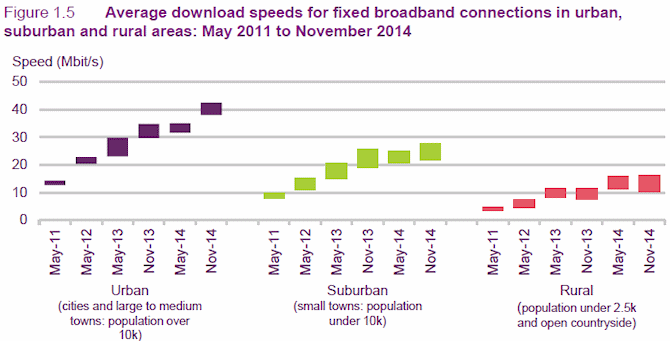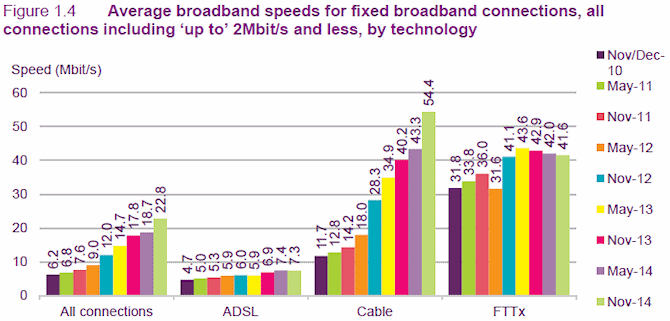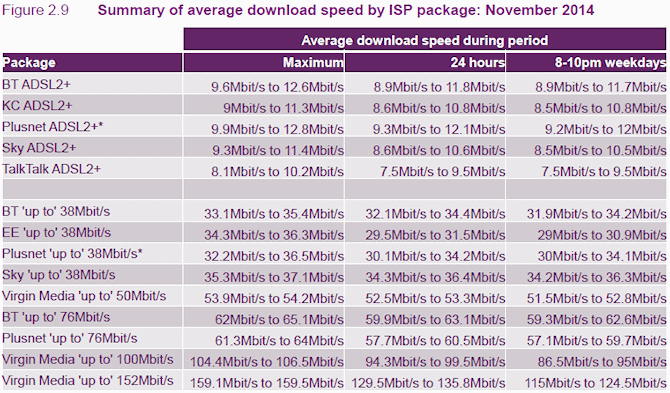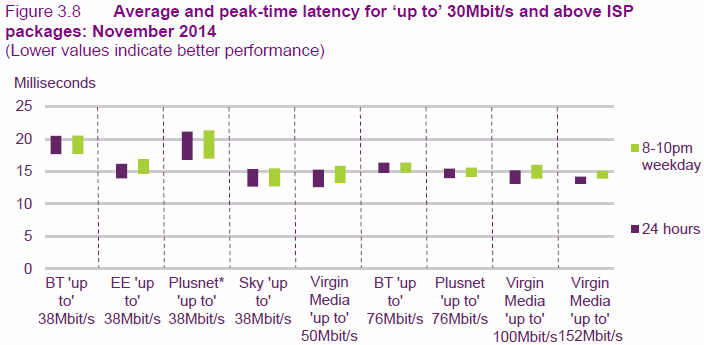Ofcom – Average UK Home Broadband Speeds Jump to Reach 22.8Mbps
The telecoms regulator has today published their latest Q1-2015 report into the real-world performance of the largest fixed line broadband ISPs and their customers across the United Kingdom, which found that the average download speed has increased by 21.93% over the past six months to top 22.8Mbps (NOTE: Most of this boost came from urban areas, with rural and suburban being fairly flat).
In addition, the average upload speed increased to 2.9Mbps (up from 2.4Mbps at the last report). Take note that Ofcom’s study is based on data gathered during November 2014, which was collected via specially modified routers from SamKnows that were installed in around 2,000 homes across the UK (these conducted a total of around 2.4 billion separate tests).
Advertisement
Sadly the limited sample size means that Ofcom’s results are only useful for reflecting the performance of those who subscribe to the markets largest ISPs, including BT, Sky Broadband, KC, EE, PlusNet, TalkTalk and Virgin Media. Never the less it’s interesting to note that, with the exception of the previous October 2014 report, the biannual performance improvements have been fairly steady.
Average UK Download Speeds (% Improvement vs Prior Report)
* February 2015 = 22.8Mbps (+21.93%)
* October 2014 = 18.7Mbps (+5.06%)
* April 2014 = 17.8Mbps (+21.09%)
* August 2013 = 14.7Mbps (+22.50%)
* March 2013 = 12Mbps (+34%)
Most of the reported performance improvement in this report stems from already well upgraded urban areas and their expanding adoption of superfast connectivity, particularly on Virgin Media’s cable network. But we’ll come back to that in a moment.

It should be noted the availability of a superfast connection method doesn’t strictly mirror take-up, and a lot of people will still be happy to stay on slower copper ADSL2+ (up to 20Mbps) lines for the time being. Meanwhile rural areas will slowly start to see an improvement through the Government’s Broadband Delivery UK programme (this aims to make speeds of 24Mbps+ available to 95% of the UK by 2017). In that sense we anticipate somewhat of a performance growth spurt from rural areas over the next few years.
So, in terms of the performance by technology type, it’s no surprise to find that older style ADSL / ADSL2+ connections haven’t really moved (they remain much the same as they were several years ago), while the average performance of Virgin Media’s cable (DOCSIS / EuroDOCSIS 3.0) based broadband network manages to push above out rival “fibre broadband” (FTTx) connections (mostly because UK FTTx lines are dominated by BT’s slower up to 40-80Mbps FTTC services).
Advertisement
We can’t help but wonder how much of an impact FTTC crosstalk interference might be having on the FTTx scores here, especially as it’s most likely to occur in busy areas.

Specific ISP Performance and Latency
Thankfully Ofcom’s report does provide a useful breakdown of performance by different ISPs and packages, including at different times of the day. This is useful for seeing how close to advertised reality the various services tend to be, especially in terms of ADSL2+ products that perform well below the common advertised rates of ‘up to’ 16-18Mbps.

In terms of mass market national broadband performance, Virgin Media clearly tops the table with their 152Mbps package and this sometimes even produces speeds of above the stated maximum.
Meanwhile FTTC products on BTOpenreach’s platform still appear to strong but be a bit more variable, especially once you pick one of the ‘up to’ 76Mbps options where issues like crosstalk interference, capacity and copper line quality constraints are likely to become far more apparent.
Advertisement
It goes without saying that some of the smaller fibre optic ISPs, such as Gigaclear, Hyperoptic, B4RN and others that offer service speeds of up to 1000Mbps, are often significantly faster than all of the ISPs listed above. But they’re sadly also too small to show up in Ofcom’s limited data sample.
Next we’ll take a quick look at Latency, which is a crucial measure of the time (delay in milliseconds [1000ms = 1 second]) that it takes for a single packet of data to travel from your computer to a remote server and then back again (ping).
Take note that a lower score (shortest time) is always best for latency and this measure is especially important for fans of online multiplayer games, where a low ping gives you smoother and more accurate gameplay.


Generally speaking there’s not a lot of difference between the ISPs and everybody should be fairly happy with the latency performance of the “superfast broadband” (30Mbps) providers, although scores of 30ms+ (e.g. TalkTalk) at the ADSL2+ end might not be perfect for some multiplayer fans (most games should still be perfectly playable).
Connection Stability
Ofcom’s report includes analysis on service disruptions (disconnections), which found that there “were no significant differences” between the average number of actual daily disconnections of 30 seconds or more for ADSL2+ based broadband services (these ranged from 0.4 to 0.9 each day per ISP).
Among the 30Mbps and above packages, the average number of daily disconnections of 30 seconds or more ranged from 0.1 each day for BT and Sky’s FTTC packages to 0.5 for PlusNet’s 76Mbps FTTC and Virgin Media’s 152Mbps cable packages. Virgin’s 152Mbps package had the most disconnections longer than two minutes, an average of 0.3 per day.
Tackling Speed Complaints
It’s worth remembering that consumer broadband services are very much a “Best Efforts” solution to Internet access, where capacity is typically shared between many users in order to keep the connection affordable. Customers that want something better still have to look towards more expensive business solutions, which often come with Service Level Guarantees (SLA) and traffic prioritisation for better performance.
Meanwhile the Government’s Broadband Delivery UK programme with BT is also slowly working towards ensuring that 95% of the UK can gain access to superfast broadband speeds by 2017 and plenty of smaller alternative providers are making big improvements of their own. On top of that BTOpenreach and Virgin Media are constantly improving their networks and thus we anticipate that performance will continue to climb as some of those upgrades are introduced over the next 2-3 years (e.g. FTTC Vectoring, DOCSIS 3.1 etc.).
On top of that Ofcom will this year make it easier to switch ISP, but this system won’t be ready until June 2015 (here). In the meantime it’s worth remembering that most of the big ISPs have also signed up to the regulators 2010 Voluntary Broadband Speed Code of Practice, which requires ISPs to explain to new customers the access line speed that they’re likely to achieve at home, and to try to resolve any problems when speeds fall significantly below the estimate.
Any ISPs that fail to resolve the above problem must allow customers to leave, without penalty, within the first 3 months of a new contract. But switching ISP without fixing the underlying issue first may not always result in better performance, although a new provider could equally show more willingness to help.
Finally, Ofcom indicates that their future reports will introduce “panel changes to ensure adequate representation of all major packages and to allow more robust analysis of the experiences of consumers in urban and rural areas“, including moving to an annual instead of biannual report frequency (expect the first of these in Q1 2016). Apparently the samples will also be rebalanced “so it is less dominated by high-speed packages” (good to hear).
Ofcom’s UK Fixed Line Broadband Speed Study (Nov 2014 Data)
http://stakeholders.ofcom.org.uk/../Fixed_bb_speeds_November_2014.pdf
Mark is a professional technology writer, IT consultant and computer engineer from Dorset (England), he also founded ISPreview in 1999 and enjoys analysing the latest telecoms and broadband developments. Find me on X (Twitter), Mastodon, Facebook, BlueSky, Threads.net and Linkedin.
« UK ISP TalkTalk Puts More Effort into Providing Support via Online Chat

















































Comments are closed